
Jericho is a Palestinian city in the West Bank. It is located in the Jordan Valley, with the Jordan River to the east and Jerusalem to the west. It is the administrative seat of the Jericho Governorate of the State of Palestine and is governed by the Palestinian National Authority as part of Area A. In 2007, it had a population of 18,346.
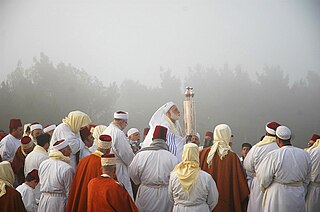
Samaritans are an ethnoreligious group who originate from the ancient Israelites. They are native to the Levant and adhere to Samaritanism, an Abrahamic and ethnic religion similar to Judaism, but differing in several important aspects.
Adummim is a place-name mentioned in the biblical Book of Joshua in connection with the ascent of Adummim.
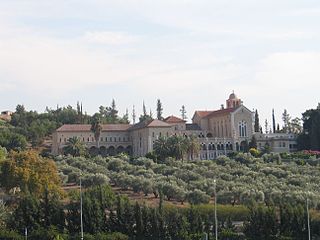
Latrun is a strategic hilltop in the Latrun salient in the Ayalon Valley, and a depopulated Palestinian village. It overlooks the road between Tel Aviv and Jerusalem, 25 kilometers west of Jerusalem and 14 kilometers southeast of Ramla. It was the site of fierce fighting during the 1948 war. During the 1948–1967 period, it was occupied by Jordan at the edge of a no man's land between the armistice lines. In the 1967 war, it was occupied by Israel.

The parable of the Good Samaritan is told by Jesus in the Gospel of Luke. It is about a traveler who is stripped of clothing, beaten, and left half dead alongside the road. First, a Jewish priest and then a Levite come by, but both avoid the man. Finally, a Samaritan happens upon the traveler. Although Samaritans and Jews despised each other, the Samaritan helps the injured man. Jesus is described as telling the parable in response to a provocative question from a lawyer, "And who is my neighbor?", in the context of the Great Commandment. The conclusion is that the neighbor figure in the parable is the one who shows mercy to their fellow man.
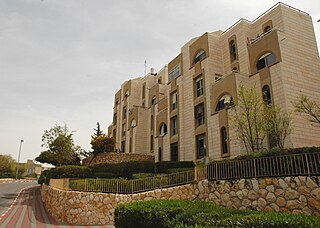
Ma'ale Adumim is an urban Israeli settlement organized as a city council in the West Bank, seven kilometers east of Jerusalem. Ma'ale Adumim achieved city status in 1991. In 2015 its population was 37,555. It is located along Highway 1, which connects it to Jerusalem and the Tel Aviv Metropolitan Area. The international community considers Israeli settlements in the West Bank illegal under international law, but the Israeli government disputes this.
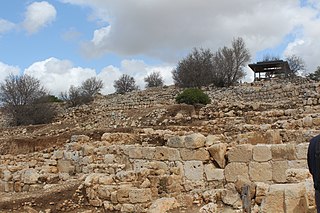
Shiloh was an ancient city and sanctuary in Samaria. According to the Hebrew Bible, Shiloh was one of the main centers of Israelite worship during the pre-monarchic period, before the First Temple in Jerusalem was built. After the Israelite conquest of Canaan, the Tabernacle was moved to Shiloh, and remained there during the period of the biblical judges.

Highway 1 is the main highway in Israel, connecting Tel Aviv and Jerusalem, and continuing eastwards to the Jordan Valley in the West Bank.

The Jericho synagogue dates to the late 6th or early 7th century CE and was discovered in Jericho in 1936. All that remains from the ancient prayer house is its mosaic floor, which contains an Aramaic inscription presenting thanks to the synagogue donors, and a well-preserved central medallion with the inscription "Shalom al Israel", meaning "Peace [up]on Israel". This led to the site also being known as Shalom Al Israel Synagogue.

Naaran is an ancient Jewish village dating to the 5th and 6th century CE, located in the modern-day West Bank. Remains of the village have been excavated north of Jericho, in Ephraim, between Bethel and Jericho. Naaran is archeologically notable for a mosaic floor of a synagogue, featuring a large zodiac design, which was discovered at the site.

Wadi Qelt, in Hebrew Nahal Prat, formerly Naḥal Faran, is a valley, riverine gulch or stream in the West Bank, originating near Jerusalem and running into the Jordan River near Jericho, shortly before it flows into the Dead Sea.
The Monastery of Martyrius, whose ruins, known as Khirbet el-Murassas in Arabic, have been excavated in the centre of the West Bank settlement and city of Ma'ale Adumim, was one of the most important centres of monastic life in the Judean Desert during the Byzantine period. It was active between the second half of the 5th and the mid-7th century.

The Monastery of Saint George of Choziba, also known as Monastery ofChoziba or Mar Jaris, is a monastery located in Wadi Qelt in Area C of the eastern West Bank, in the Jericho Governorate of the State of Palestine. The cliff-hanging complex, which emerged from a lavra established in the 420s and reorganised as a monastery around AD 500, with its ancient chapel and irrigated gardens, is active and inhabited by Greek Orthodox monks. It houses the relics of Saint George of Choziba, after whom the monastery is named, as well as the relics of Saint John of Choziba (420/450-520/530) and those of Saint John of Choziba the Romanian (1913-1960)
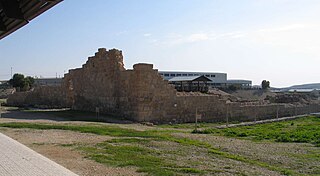
The Monastery of Euthymius started as a lavra-type monastic settlement in the Judaean desert, founded by Saint Euthymius the Great (377–473) in 420, known as the Laura or Lavra of Euthymius. After its final abandonment in the 13th century, it was repurposed as a caravanserai and became known as Khan el-Ahmar, the Red Caravanserai, khan being an originally Persian word for inn or caravanserai. Its ruins still stand a short distance south of today's main Jerusalem-Jericho highway in the West Bank.

The ancient synagogue of Gaza was built in 508 CE during the Byzantine period and was discovered in 1965. It was located in the ancient port city of Gaza, then known as "Maiumas", currently the Rimal district of Gaza City.
The architecture of Palestine covers a vast historical time frame and a number of different styles and influences over the ages. The urban architecture of the region of Palestine prior to 1850 was relatively sophisticated. The Palestinian townhouse shared in the same basic conceptions regarding the arrangement of living space and apartment types commonly seen throughout the Eastern Mediterranean. The rich diversity and underlying unity of the architectural culture of this wider region stretching from the Balkans to North Africa was a function of the exchange fostered by the caravans of the trade routes, and the extension of Ottoman rule over most of this area, beginning in the early 16th century through until the end of World War I.

Khan al-Ahmar is a Palestinian village located in the Khan al-Ahmar area of the Jerusalem Governorate of the West Bank. In 2018, there were between 173 and 180 Bedouin, including 92 children, living there in tents and huts, upwards of 100 in 2010, with its local school serving the needs of 150 children in the area. Khan al-Ahmar is located between the Israeli settlements of Ma'ale Adumim and Kfar Adumim on the north side of Highway 1, between the junctions with Route 437 and Route 458.

Qasr al-Yahud, also known as Al-Maghtas, is the western section of the traditional site of the baptism of Jesus by John the Baptist on the Jordan River. It has also been traditionally identified with two episodes from the Hebrew Bible, as one of the possible points through which the Israelites have crossed the Jordan river as they reached the Promised Land, and as the site where prophet Elijah ascended to heaven. "Qasr al-Yahud" is actually an Arabic name given to the nearby Monastery of St John the Baptist, but is also being used for the West Bank section of the baptism site itself.

Khirbet Samara is an archaeological site located in the West Bank. It lies near the Israeli settlement of Einav, 9 km east of Taibe.

























